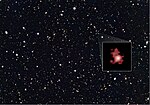astro.wikisort.org - Meteorite
TRAPPIST-1c, also designated as 2MASS J23062928-0502285 c, is a mainly rocky, Venus-like exoplanet orbiting around the ultracool dwarf star TRAPPIST-1 approximately 40 light-years away from Earth in the constellation Aquarius. It is the most massive and third largest planet of the system, with about 116% the mass and 110% the radius of Earth. Its density indicates a primarily rocky composition with a very thick Venus-like atmosphere, although it is expected to be thinner than that of TRAPPIST-1b.
 Artist's impression of TRAPPIST-1c (February 2018) | |
| Discovery | |
|---|---|
| Discovery date | May 2, 2016 |
Detection method | Transit |
| Orbital characteristics | |
| Apastron | 0.015919 +0.000028 −0.00003 AU |
| Periastron | 0.015712 +0.000028 −0.00003 AU |
Semi-major axis | 0.01581512 ± 1.5e-07[1] AU |
| Eccentricity | 0.00654 ± 0.00108[1] |
Orbital period (sidereal) | 2.42180746 ± 0.00000091[2] d |
| Inclination | 89.70 ± 0.18[2] |
| Star | TRAPPIST-1[3] |
| Physical characteristics | |
Mean radius | 1.095 +0.031 −0.030[1] REarth |
| Mass | 1.156 +0.131 −0.142[1] MEarth |
Mean density | 4.87 +0.43 −0.46 g/cm3 g cm−3 |
Surface gravity | 0.966 +0.087 −0.092[1] g |
| Temperature | Teq: 334.8 ± 4.7 K (61.65 ± 4.70 °C; 142.97 ± 8.46 °F)[2] |
Physical characteristics
Mass, radius, and temperature
TRAPPIST-1c was observed with the transit method, which enabled scientists to calculate its radius. Transit-timing variations and computer simulations were able to determine the mass, density, and gravity of the planet. TRAPPIST-1c is the third-largest planet of the TRAPPIST-1 system, with a radius of 1.095 REarth. It is also the most massive of the system as well, with a mass of 1.156 MEarth, slightly higher than that of the next most massive, TRAPPIST-1g. Despite its Earth-like mass and radius, TRAPPIST-1c has a lower density (4.89 g/cm3) and gravity (0.966g) than Earth. This is consistent with a rock-based composition and a thick, Venus-like atmosphere, similar to TRAPPIST-1b. TRAPPIST-1c's atmosphere is expected to be thinner than that of its inner sibling, but still large enough to raise its surface temperature far above the calculated 334.8 K (61.7 °C; 143.0 °F) equilibrium temperature.[1][2]
Orbit
The orbit of TRAPPIST-1c is very close to its host star. One year on this planet lasts a mere 2.42 days (58 hours), a fraction as long as that of our Solar System's innermost planet, Mercury. The planet orbits at a distance of 0.0158 AU, which is about 1.6% the distance between Earth and the Sun. At this proximity, TRAPPIST-1c is most likely tidally locked. However, due to the small size of its host star, the planet only receives about 2.1 times the sunlight as Earth (similar to Venus, at 1.9 times). Its orbital eccentricity is very low at 0.00654, similar to that of TRAPPIST-1b.
Host star
TRAPPIST-1c orbits the ultracool dwarf star TRAPPIST-1. It is 0.121 R☉ and 0.089 M☉, with a temperature of 2511 K and an age between 3 and 8 billion years. For comparison, the Sun has a temperature of 5778 K and is about 4.5 billion years old. TRAPPIST-1 is also very dim, with about 0.0005 times (0.05%) the luminosity of the Sun. It is too faint to be see with the naked eye, having an apparent magnitude of 18.80.
Atmosphere
The combined transmission spectrum of TRAPPIST-1 b and c rules out a cloud-free hydrogen-dominated atmosphere for each planet, so they are unlikely to harbor an extended gas envelope. Other atmospheres, from a cloud-free water-vapor atmosphere to a Venus-like atmosphere, remain consistent with the featureless spectrum.[4]
In 2018, the composition of TRAPPIST-1c was determined, and has been found to be rock-based with a very thick, Venus-like atmosphere. The atmosphere of TRAPPIST-1c is likely thinner than that of TRAPPIST-1b.[5][1]
See also
References
- Grimm, Simon L.; Demory, Brice-Olivier; Gillon, Michael; Dorn, Caroline; Agol, Eric; Burdanov, Artem; Delrez, Laetitia; Sestovic, Marko; Triaud, Amaury H.M.J.; Turbet, Martin; Bolmont, Emeline; Caldas, Anthony; de Wit, Julien; Jehin, Emmanuel; Leconte, Jeremy; Raymond, Sean N.; Van Grootel, Valerie; Burgasser, Adam J.; Carey, Sean; Fabrycky, Daniel; Heng, Kevin; Hernandez, David M.; Ingalls, James G.; Lederer, Susan; Selsis, Franck; Queloz, Didier (2018). "The nature of the TRAPPIST-1 exoplanets". Astronomy & Astrophysics. 613: A68. arXiv:1802.01377. Bibcode:2018A&A...613A..68G. doi:10.1051/0004-6361/201732233.
- Delrez, Laetitia; Gillon, Michael; H.M.J, Amaury; Brice-Oliver Demory, Triaud; de Wit, Julien; Ingalls, James; Agol, Eric; Bolmont, Emeline; Burdanov, Artem; Burgasser, Adam J.; Carey, Sean J.; Jehin, Emmanuel; Leconte, Jeremy; Lederer, Susan; Queloz, Didier; Selsis, Franck; Grootel, Valerie Van (2018). "Early 2017 observations of TRAPPIST-1 with Spitzer". Monthly Notices of the Royal Astronomical Society. 475 (3): 3577–3597. arXiv:1801.02554. Bibcode:2018MNRAS.475.3577D. doi:10.1093/mnras/sty051.
- Van Grootel, Valerie; Fernandes, Catarina S.; Gillon, Michaël; Jehin, Emmanuel; Scuflaire, Richard; et al. (2018). "Stellar parameters for TRAPPIST-1". The Astrophysical Journal. 853: 30. arXiv:1712.01911. Bibcode:2018ApJ...853...30V. doi:10.3847/1538-4357/aaa023.
- de Wit, Julien; et al. (2016). "A combined transmission spectrum of the Earth-sized exoplanets TRAPPIST-1 b and c". Nature. 537 (7618): 69–72. arXiv:1606.01103. Bibcode:2016Natur.537...69D. doi:10.1038/nature18641. PMID 27437572.
- Landau, NASA, Liz. "New clues to compositions of TRAPPIST-1 planets". Exoplanet Exploration: Planets Beyond our Solar System. Retrieved 21 May 2021.
На других языках
[de] Trappist-1 c
Trappist-1 c, auch als 2MASS J23062928-0502285 c bezeichnet, ist ein vermutlich felsiger Exoplanet, der den Zwergstern Trappist-1 außerhalb der habitablen Zone umkreist. Er befindet sich etwa 40 Lichtjahre (12 Parsec) von der Erde entfernt im Sternbild Wassermann.- [en] TRAPPIST-1c
[ru] TRAPPIST-1 c
TRAPPIST-1 c — экзопланета у звезды TRAPPIST-1 в созвездии Водолея, относящаяся к землеподобным планетам. Вторая по отдалённости от звезды из семи планет в системе. Открыта 2 мая 2016 года с помощью телескопа TRAPPIST вместе с планетами TRAPPIST-1 b и TRAPPIST-1 d[1][2][3]. Параметры были уточнены на пресс-конференции NASA 22 февраля, на которой также сообщили об обнаружении планет e, f, g и h[4][5][6], а также после публикования данных, собранных телескопом «Кеплер»[7].Другой контент может иметь иную лицензию. Перед использованием материалов сайта WikiSort.org внимательно изучите правила лицензирования конкретных элементов наполнения сайта.
WikiSort.org - проект по пересортировке и дополнению контента Википедии




